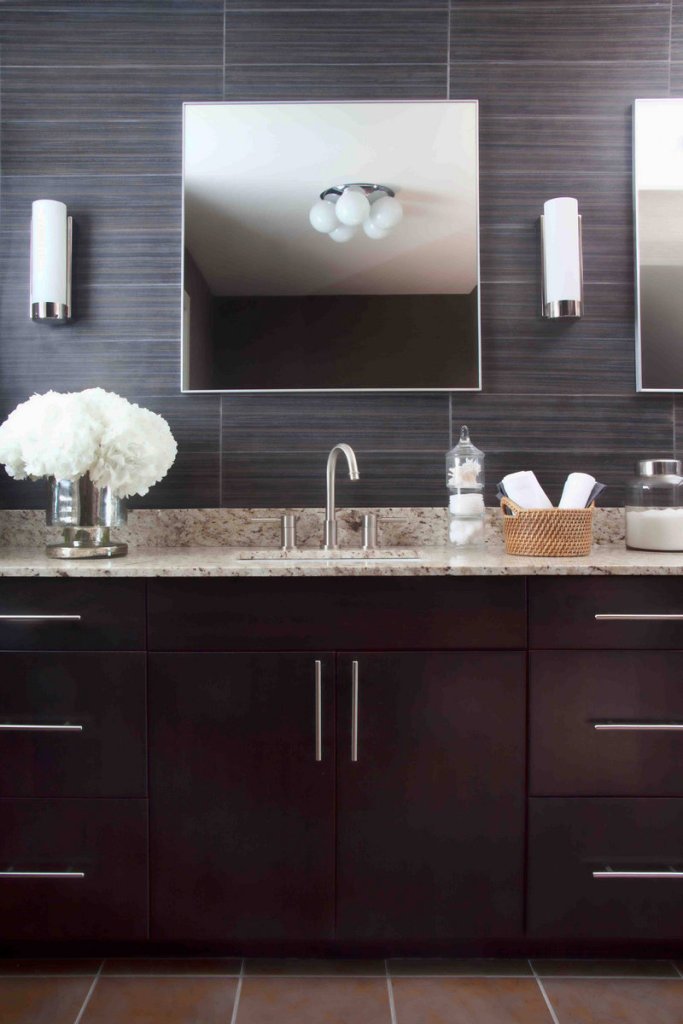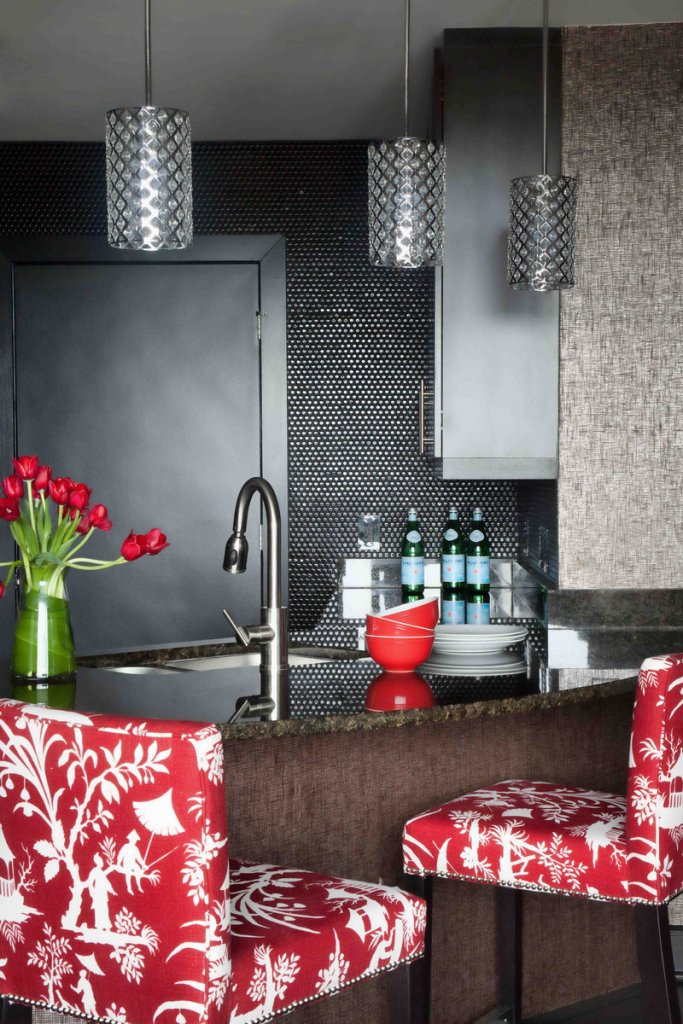Choosing tile for your home once meant picking from among a handful of pastel ceramic squares. Would it be dusty pink or dusty blue? If you were feeling bold, maybe mint green or pale yellow?
Today, we’re surrounded — some might say overwhelmed — by choices.
Porcelain tile is now made to realistically look like everything from aged wood and rough fieldstones to sleek Italian marble. Tiles made of glass, cork, mirror and even leather are taking the place of traditional ceramics. In all shapes and sizes, they are being used not just in kitchens and baths, but also in entryways, mudrooms and more.
High style can be had for an increasingly reasonable cost, with mass-market retailers offering trendy glass tile for as little as a few dollars per square foot.
Amid all these possibilities, the biggest challenge is to choose something you’ll continue loving for a decade or more.
“There’s so much decorative tile out there now,” says Matthew Quinn, principal of Design Galleria Kitchen and Bath Studio in Atlanta. But “some of it,” he says, “you can just tell in three or four years this is not something you’re going to want to see every day.”
Unlike paint and wallpaper, tile isn’t something easily and affordably changed every few years.
Here, Quinn and interior designers Brian Patrick Flynn and Mallory Mathison share ideas on embracing tile’s new possibilities while still creating a timeless effect.
FLOOR TO CEILING: All three designers are fans of using tile all the way up to the ceiling, rather than the more old-fashioned approach of doing partial tile walls with a snub-nosed edge.
“It makes the entire room more cohesive, and it can also give the illusion that a space is larger than it actually is,” says Flynn. “One of the easiest ways to shrink a room visually is by chopping it up; many times, for me, tile used in just one area quickly chops up a space.”
Flynn has done kitchen walls in floor-to-ceiling tile, and Mathison recommends tiling a single wall from top to bottom in an entryway for a striking effect.
“You think of tile more in utilitarian applications,” she says, “but it can be a beautiful accent.” A full wall of tortoise-shell mosaic tile, she says, feels “almost like your whole wall is covered in jewelry.”
Clients sometimes assume full walls of tile will make a project expensive, says Quinn. But the cost depends entirely on your choice of tile: “You can find a fabulous white crackled subway tile for less than $3 a square foot,” he says. “For about $1,000, you can cover every wall of a bathroom, floor to ceiling, and it’s extremely durable.”
BEYOND CERAMICS: Flynn loves using tiles made of “unexpected materials, such as leather, cork and wood. Leather tiles can be used on walls and ceilings, but in lower-traffic areas. Cork is a dream because it helps soundproof a space, plus it offers a really warm, organic texture instead of the sleek ceramic surfaces we’re used to seeing.”
“Wooden tiles are rather pricey,” Flynn says, but Quinn points out that manufacturers such as Porcelanosa now offer porcelain tiles that look strikingly like real wood. They are durable, resistant to moisture and need no maintenance.
Mirrored tiles are another option, and Mathison promises they don’t have to evoke the 1970s. She uses large mirrored tiles mounted only with mastic, not grout, with no visible lines between them. Many glass and mirror stores will cut them in custom sizes for you, she says.
ALTERNATING SIZES, COLORS OR DEPTHS: Traditionally, a homeowner chose a particular tile and used it throughout a space. Quinn says clients love the effect when he alternates large and small tiles in various patterns.
Simple changes like using “two different size subway tiles — 2-by-4 and 3-by-6 — alternating stripes of one and then the other,” can make a bathroom more stylish and interesting, without becoming outdated quickly.
Another option, he says, is using different thicknesses of the same tiles, so that some rows of tile jut out further than others, creating “really cool, undulating patterns.”
In his own kitchen, Flynn recently used 2-foot-by-6-inch rectangular tiles in a muted mix of grays and browns. But “instead of installing them in a staggered manner, I had them installed stacked directly on top of one another for a linear look,” he says. The effect is very Mid-Century Modern, “similar to the exterior of a Palm Springs home.”
You can also get creative with grout: Simple white or beige tiles can be installed with thin, barely visible lines of grout, or thick lines of grout in bold or dark colors that contrast with the tile.
Mathison often uses “as close to a zero grout line as possible,” which can make smaller baths or kitchens seem larger. But some clients want “a strong, graphic statement that really defines the edges of the tile.” In those cases, she’ll use a charcoal gray or blue-green grout against white tile for a bold look that still feels clean and classic.
THE QUESTION OF GLASS: Glass tile has become popular. Because it’s translucent, Mathison sometimes uses it in smaller bathrooms: “Your eye kind of looks through it, so it doesn’t create a boundary,” she says. “It’s an almost limitless look” that can make a small shower area feel larger.
But glass tile can be expensive, Flynn says, and it’s gotten trendy. One fresh option is “using extra-large, extra-wide, back-painted glass panels on walls,” rather than small glass tiles, “to bring contemporary architectural interest into a space.”
“Although I do actually love it, glass tile has become so popular and embraced by builders and developers that I fear it will be associated with ‘early millennium,’ similar to how flocked wallpaper is thought of as 1970s or mauve being indicative of the 1980s,” he said.
DON’T DO IT YOURSELF: It’s possible to remove old tile and install new on your own. But all three designers recommend hiring professionals.
Even the highest quality tile will look unattractive if it’s been installed incorrectly. And demolition and tile cutting can be dangerous.
“When clients ask me where to spend and where to save in bathrooms and kitchens,” says Flynn, “I always say, ‘We can save on materials, we can save on fixtures, but the one place we always must splurge is on hiring the right tile installation professional.’ “
Send questions/comments to the editors.




Success. Please wait for the page to reload. If the page does not reload within 5 seconds, please refresh the page.
Enter your email and password to access comments.
Hi, to comment on stories you must . This profile is in addition to your subscription and website login.
Already have a commenting profile? .
Invalid username/password.
Please check your email to confirm and complete your registration.
Only subscribers are eligible to post comments. Please subscribe or login first for digital access. Here’s why.
Use the form below to reset your password. When you've submitted your account email, we will send an email with a reset code.